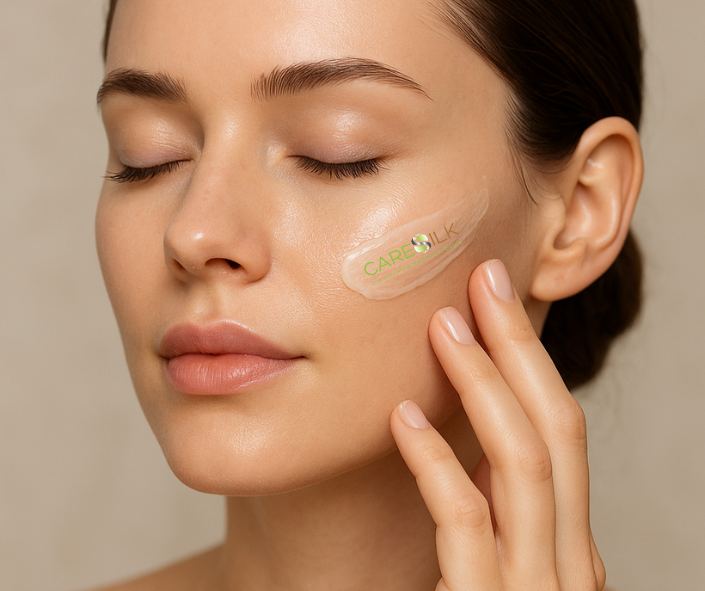Peptides derived from sericin represent one of the most promising frontiers in regenerative cosmetic research, as they possess marked bioactivity on skin cells. Enzymatic or acidic hydrolysis of the protein produces low- and medium-molecular-weight peptide sequences with high bioavailability and strong affinity for specific cellular receptors. Numerous in vitro studies have demonstrated that these fragments stimulate the proliferation of keratinocytes and dermal fibroblasts, two key cell lines for re-epithelialization and extracellular matrix production. Activation of intracellular signaling pathways, particularly MAPK/ERK and PI3K/Akt, results in upregulated expression of genes involved in the synthesis of type I and III collagen and glycosaminoglycans, all critical for dermal elasticity and tensile strength. This biological activity positions sericin not merely as a functional ingredient but as an active modulator of skin physiology, with potential roles as a biostimulant in advanced anti-aging and regenerative protocols.
Film-forming properties and modulation of the skin barrier
One of the most distinctive features of sericin is its unique affinity for keratin in the stratum corneum. The high content of polar amino acids such as serine, threonine, aspartic acid, and glycine enables hydrogen bonding with keratin polypeptide chains, ensuring selective and stable adhesion to the skin surface. This leads to the formation of a thin, transparent, biocompatible film that significantly reduces transepidermal water loss (TEWL), prolonging hydration and providing immediate cutaneous comfort. However, this effect is not limited to a passive barrier action: the sericin-derived microfilm alters stratum corneum permeability, creating a microenvironment more favorable to the diffusion and bioavailability of hydrophilic molecules. This makes sericin a strategic ally in the formulation of complex cosmetic systems, functioning both as a regenerative active and as a natural enhancer for other functional compounds. Clinical evidence shows that topical formulations containing sericin lead to long-lasting improvements in skin texture, with reduced dryness and enhanced luminosity, both parameters strongly associated with a healthier and more resilient skin barrier.
Antioxidant activity and protection against reactive species
In addition to its regenerative and moisturizing effects, sericin is distinguished by its ability to counteract oxidative damage, one of the primary drivers of premature skin aging. Sericin-derived peptides contain functional groups such as hydroxyl and free carboxyl moieties, which efficiently neutralize reactive oxygen and nitrogen species (ROS and RNS). This translates into a reduction of lipid peroxidation processes that compromise membrane integrity and accelerate dermal tissue degeneration. Furthermore, sericin demonstrates metal-chelating activity, particularly against iron and copper ions, thereby reducing Fenton-type reactions responsible for the generation of highly damaging radicals. The antioxidant potential of sericin not only plays a preventive role but also helps preserve the functionality of structural skin proteins, protecting collagen and elastin from degradation induced by UV radiation and environmental pollutants. These mechanisms firmly establish sericin as a key ingredient in high-performance anti-aging formulations, capable of combining protective and regenerative actions.
Synergy with advanced delivery technologies
The actual efficacy of bioactive peptides depends not only on their inherent biological activity but also on their ability to penetrate and act within targeted skin layers. For this reason, recent cosmetic research has focused on advanced delivery systems designed to stabilize and gradually release sericin. Among the most promising platforms are nanoliposomes, polymeric nanoparticles, and hybrid complexes with fibroin, which create biocompatible matrices that optimize release kinetics and peptide stability. The incorporation of sericin into hydrogels or nanostructured scaffolds has demonstrated improved epidermal absorption, allowing for deeper and more uniform tissue penetration. These solutions enable sericin to be co-delivered with other actives such as hyaluronic acid or lipophilic vitamins, amplifying its synergistic effect. Clinical pilot studies on formulations based on advanced delivery systems have reported significant improvements in skin elasticity, firmness, and reduction of periocular fine lines, confirming sericin’s potential in next-generation dermocosmetics.
Application perspectives and clinical validation
The prospects for sericin in regenerative skincare are wide-ranging and increasingly supported by robust scientific evidence. Beyond preclinical findings, available clinical trials confirm tangible benefits such as improved skin hydration, firmness, and wrinkle depth reduction after regular treatment periods of 4–8 weeks. Sericin’s efficacy is particularly evident in skincare protocols targeting mature, photo-damaged, or environmentally stressed skin, where its combined effects—bioactivity, barrier reinforcement, and antioxidant protection—generate unique synergistic outcomes. A particularly relevant aspect is its ability to be integrated with other high-performance biomaterials and actives, including biomimetic peptides, cross-linked hyaluronic acid, niacinamide, and stabilized retinoids. The combination of these agents allows for the development of multi-target formulations capable of simultaneously enhancing regeneration, deep hydration, and antioxidant defense. Looking forward, sericin is poised to become a cornerstone ingredient in personalized cosmetic approaches, with applications spanning both at-home treatments and professional dermatological or aesthetic protocols. Current clinical validation and growing evidence clearly highlight sericin’s transition from a byproduct of silk processing into a strategic biomaterial for advanced regenerative skincare.


